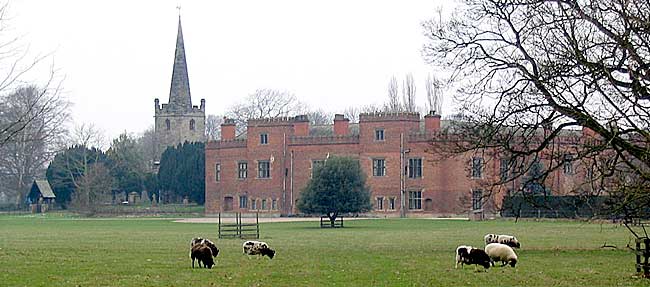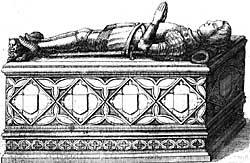Holme Pierrepont

Holme Pierrepont Hall and church in 2004. The brick south entrance range seen here dates from the early 16th century.
HOLME was the old Danish word for a riverside meadow; Pierrepoint it is hardly necessary to say, is the name of the family of early owners, and it was added to distinguish this village from the Holme, near Newark, and others of the same appellation. Some of its field-names proclaim their Saxon origin, but the discoveries of pottery here in 1839 indicated Roman associations, while the cinerary urns found in the "terrace gravel" at the same time denoted a cremation cemetery dating from the time of the earliest Saxon invasions.
The Domesday survey mentions no church here, but although that in itself is not proof that none existed, such was nevertheless probably the case. Holme may have been a small village under the Saxon and Danes, and there was a church near by at Adbolton where the inhabitants of this settlement may have worshipped. If so, time brought its revenge, for in 1707 the two places were ecclesiastically united, and when Adbolton Church was pulled down in 1746, some of its material went for the repair of the church of Holme Pierrepoint
At the Conquest, the last of its Saxon owners, Toret, was displaced by the great Norman lord. Roger de Busli, to whom no less than 174 manors were granted in this county alone, but Roger farmed out all its land, reserving none for his own use. After founding Blyth Priory, and building Tickhill Castle as his chief seat, he died in 1093, and in the following century his line became extinct. During the turmoils of the disputed accessions of Rufus and Henry I, the Manvers family established itself here, and perhaps one of them founded the first church and erected the original Hall or converted that of Toret into a residence protected bya moat. The earliest known reference to the church occurs in a record of 1201, when Ralph Plucket parted with its advowson to Michael Manvers, but three years later Plucket forfeited his possessions for being in arms against John, and Manvers bought presentation outright from the king for 100s.
In the reign of Edward I (1272-1307) Annora, heiress of the Manvers family, brought Holme to Henry de Pierrepoint, by marriage, and thenceforth, until the sale in December, 1941, the village remained the property of this Norman house. The new owner was a litigious and oppressive person who was involved in several lawsuits in which he was not always successful. At Sneinton, he sough to reduce his free tenants to servitude as villeins and, undeterred by a verdict against him at his first attempt, he achieved his object, later by finding a more complaisant jury. It is likely that the inhabitants of Holme, in common with those of such parts, of Gamston and Adbolton as belonged to this manor, would benefit little from the change of ownership.
Towards the close of the 14th century, the church was replaced by a new and doubtless larger one, of which the embattled tower, the arcade, the head of a two-light window in the north wall at the western end, and the font survive. Dr. Cox states that the spire (of Gedling stone) was built about a hundred years later, and Mr. Harry Gill suggested that it dates from the time of Henry VII. The church is dedicated to St. Edmund and is one of the four dedications to that once popular saint in the shire. Some of its early clergy were not models of propriety; one or two were outlawed for debt, another was heavily fined for delinquencies, and the rector of 1299 was convicted of a serious offence against morality.
Wars of the Roses

Monument to Sir Henry Pierrepont (died 1499) as it appeared in 1676.
In the long Wars of the Roses, Sir Henry Pierrepoint fought for the Yorkists and took with him such retainers as he could muster. The knight rendered good service to Edward IV and in 1464 was duly rewarded for his "good and laudable services at his great cost and charges, and with manifold bodily dangers against the king's rebels levying war against him." His guerdon was "a third part of the manor of Staveley, with a like part of the advowson of the church there and a chantry in that church." Not all of those who followed his flag lived to return, and two of the Pierrepoints fell in a skirmish on Papplewick Moor. At the east end of the church is a well carved alabaster tomb of a knight of this period. Its effigy depicts a man of refined features, wearing a Yorkist collar and armour, with abundance of rings on his fingers, and upraised hands. It is doubtless that of this warrior, who was buried here amongst his ancestors in 1499. The stone figure near the south door is the most ancient of the many monuments and it is supposed to represent a pilgrim of whom nothing is known.
A warlike scene was witnessed here in June, 1487, when Henrv VII was marching from Loughborough to cut off the rebel Earl of Lincoln, who with Martin Schwartz was hastening to cross the Trent and make for London to place their puppet-claimant, Lambert Simnel, on the throne. Henry quartered his troops in the fields outside Nottingham, and himself sought a night's repose at a mansion three miles away "beside the main road." This mansion has been conjectually identified with Holme Pierrepoint Hall. Early next morning he hurried to Nottingham, where his presence was required, for he had been missed, and the alarming rumour had spread through the camp that he had betrayed them and fled. After attending divine service in St. Mary's Church, he at once resumed his march, leaving some of the rumour-mongers swinging from the trees by the Leen Bridge, near the foot of Hollow Stone. Passing by Holme Pierrepoint and proceeding through Radcliffe to Bingham, he rested his army there, and early next morning moved on to East Stoke, where his complete victory ended the War of the Roses and established the Tudor dynasty of monarchs.
In 1495 Sir Henry Pierrepoint bequeathed "£20 to the making of Polleford brigge and the amending of the high way beside Holme to be wared upon theym by the discrecion of myne executors." He had made gifts to the parish church, which underwent much restoration or rebuilding then. It has been suggested that some of its discarded stone was used to strengthen the bank of the Trent for the better protection of the village against the recurrent floods.
Enclosure of Land
His successor, Sir William, followed the new money-making fashion of converting his arable lands into pasture for sheep on account of their wool. The enclosure introduced hedges and fields, and, since less labour was required for grazing lands than for tillage, ploughs were "put down" or done away with, and labour was displaced. Some 140 acres of arable land and 80 acres of meadow were so enclosed, and as the inhabitants lost their livelihood they had to quit their homes. In 1517 it was found that six plough teams had been suppressed, dwellers had been "driven forth and cast forth from their holdings," the population had diminished, and six houses which had been abandoned but not demolished were falling into ruin. As each plough was reckoned to employ six labourers and each labourer may have had a family, Holme Pierrepoint suffered a great change in or about 1500. This procedure was then general enough to attract Government attention, and in 1515 the first of a series of Acts was passed to check it and restore the labourers to their work and homes. Little success attended these laws and here they were inoperative: from that time onwards the enclosures remained and amid the wastes and commons around them the fields have persisted.
In 1536 occurred the formidable rebellion known as the Pilgrimage of Grace, when Catholic rebels for a time dominated the kingdom north of the Trent, and nearly deprived Henry VIII of his crown. Once again the Trent was the vital barrier, and between Nottingham and Newark its banks were ceaselessly patrolled for the king, all boats bring drawn to its southern side, and the fords heavily guarded. Holme Pierrepoint was inevitably involved in this critical strife, but as some (at least) of the Pierrepoints and other inhabitants were Papists, local sympathies and hopes would be divided.
